An isolation transformer provides physically and electrically isolation between two circuits. It isolates as well as protects the electrical & electronic circuits.
A transformer is a static device that is used to either step up or step down a particular voltage level from a different voltage level which it does with constant frequency and works on the principle of magnetic induction it has different voltage levels on either side and can function as both steps up or step down transformer.
What is an Isolation Transformer?
An isolation transformer is most similar to a basic transformer, but with the feature that it has the same number of turns on the primary and secondary sides. Therefore, the voltage on both sides of the transformer is the same. Here, like a step-up or step-down transformer, the energy transfer from the primary to the secondary takes place on the principle of electromagnetic induction.
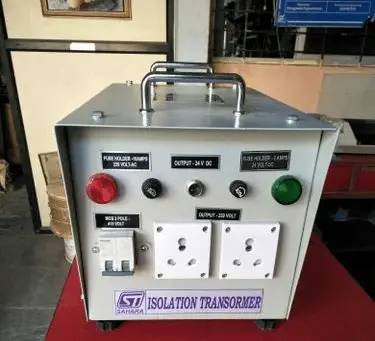
In step-up transformers, the secondary voltage(V2) is more than the primary voltage(V1). The reason for this is that the secondary turns (N2) are more than the primary turns(N1). The same is the opposite in the step-down transformer. The secondary of the step-down transformer has less number of turns than the primary turns. Therefore, the secondary voltage(V2) is less than the primary voltage(V1).
However, the primary turns (N1) and secondary turns (N2) are equal for an isolation transformer. Therefore, the primary current (I1) and secondary current (I2) are equal. Hence, the isolation transformer is also called a 1:1 turns ratio transformer, and its construction is similar to two winding transformers.
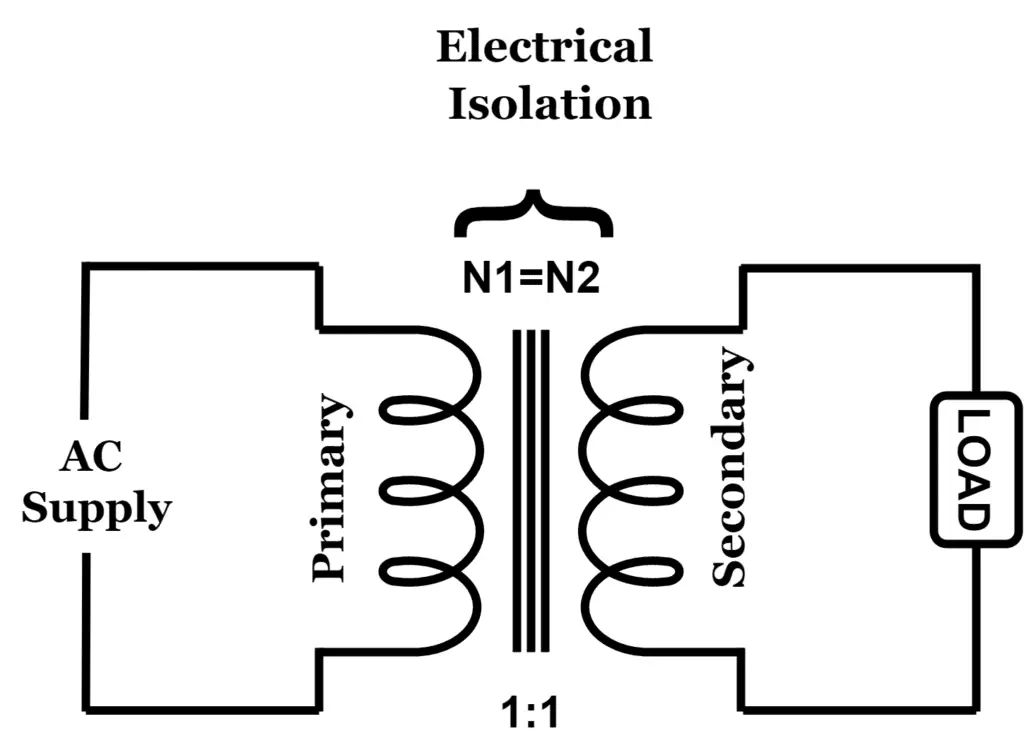
The below table shows the summary of the features of the step-up, step-down, and isolation transformer.
| S.No | Winding Turns | Voltage | Current |
| Step-up Transformer | N2 > N1 | V2 > V1 | I2 <I1 |
| Step-down Transformer | N2 < N1 | V2 < V1 | I2 >I1 |
| Isolation Transformer | N2 = N1 | V2 = V1 | I2 = I1 |
Function of Isolation Transformer :
The isolation transformer is used to serve the following functions.
1. Reduction in Magnitude of Voltage Spikes
The voltage spikes in the power system occur because of lightning, static electricity, electrical faults, and sudden variation in the supply side. The voltage spikes are very dangerous for electrical and electronic equipment, and these spikes can damage the equipment. We can say the voltage spike is a sudden rise in the voltage levels for a very short duration (3 nanoseconds or more) traveling at high speed.

The isolation transformer has the capability to impede these voltage spikes, and thus it reduces the voltage spikes in the supply system.
The magnitude of the voltage spikes may vary from a few volts to several thousand volts. The high voltage can cause insulation failures and equipment is most vulnerable to these high voltage spikes. Now, let us see how the isolation transformer installed in between the supply system and the equipment safeguards the equipment against voltage spikes.
The primary winding of the isolation transformer has inductive properties. The inductor always opposes the sudden change in the current. When the high voltage spikes are superimposed on the power frequency, the transformer draws a large current. However, the primary of the transformer does not instantaneously allow this enormous change in the current. The current is allowed to pass in an exponential way.
With an increase in the current, the flux also increases and the increased flux linking to primary and secondary induces a voltage in both windings of the transformer. The additional induced voltage due to the spike opposes the incoming voltage and thus transformer impedes the current passing through it. The decrease in the current causes a reduction in the flux and thus, the magnitude of the spike voltage at the secondary side of the transformer gets reduced.
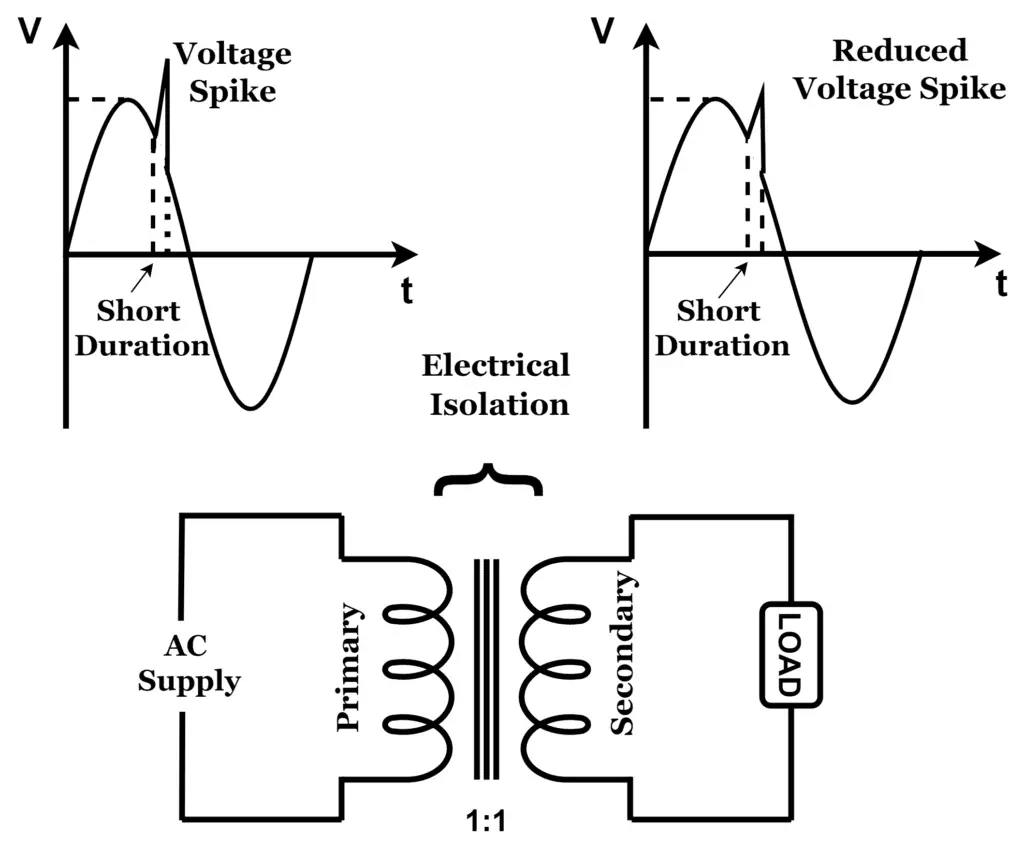
The voltage spikes are characterized by a fast-charging voltage and current, therefore the opposition to voltage spikes at the primary and secondary sides of the isolation transformer is more. Thus, the magnitude of the voltage spike at the secondary or load side gets greatly reduced.
2. Eliminates the grounding of load equipment
An isolation transformer eliminates the grounding of load equipment or the secondary side. Thus, it eliminates the ground loop interference and noise effects on the load.
An isolation transformer is used to ensure the safety and protection of the sensitive equipment from voltage spikes, ground loops, and other power line distortions.
Design consideration of Isolation Transformer
But one thing must be kept in mind while designing an isolation transformer, the capacitance between the winding creates capacitive coupling that allows AC signal to pass from the primary to the secondary side and thus increase the noise level. So to avoid this, the winding is surrounded by a metallic strip, and the strip is further grounded for electrostatic shielding. The electrostatic shielding additionally suppresses the electrical noise.
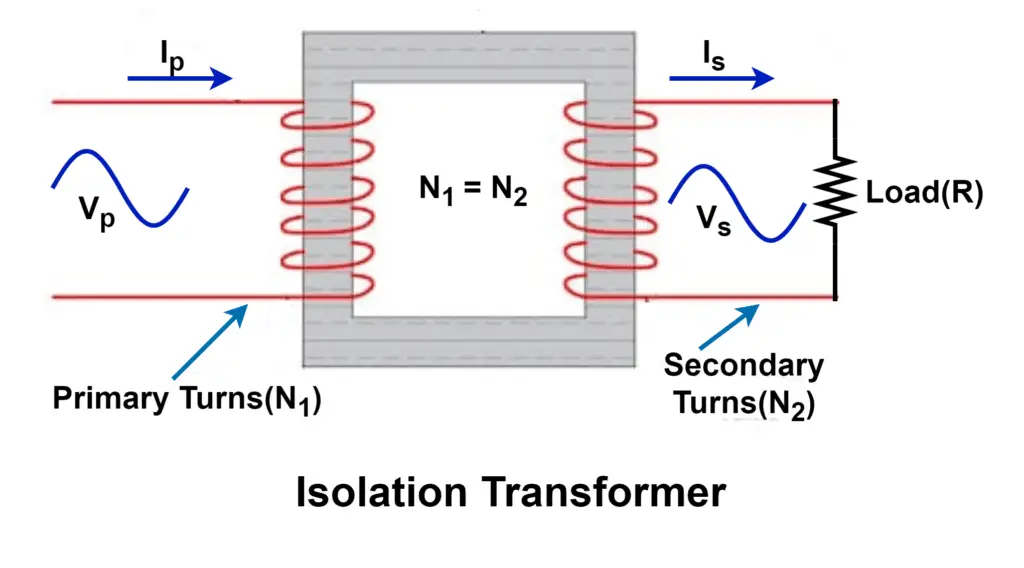
An autotransformer can never be used as an isolation transformer as it has only one winding in common and has connected primary and secondary winding.
The core of the isolation transformer is made of silicon iron or nickel-iron core and for high-frequency applications, the core is made of amorphous alloy.
It is mostly used to isolate a high-voltage circuit from a low-voltage circuit and thus it is used in electronic circuits. It also serves the safety of personnel.
Applications of Isolation Transformer
- An isolation transformer is used as a Pulse transformer in power electronics devices. When it is used in a pulse circuit it is called a pulse transformer. It provides isolation between the high-power supply circuit and the low-power gate circuit and protects low-powered electronic devices from voltage surges. It also generates a rectangular pulse which is supplied to the gate terminal for triggering power semiconductor devices.
- Isolation transformer in ultra isolation mode built with special features eliminates common mode signal. Here, the transverse mode noise gets reduced and also common mode noise gets attenuated with the use of high-isolating materials and specialized shielding techniques. Ultra mode isolation transformer is used for very sensitive computer peripherals and CNC machines etc.
- Isolation transformers with electrostatic shields are used for power supplies for sensitive instruments in medical and laboratory.
- It is used to reduce or eliminate voltage spikes in supply lines that arise due to sudden changes in supply voltage or lighting. The isolation transformer absorbs the incoming spikes from the input side and maintains a steady voltage at the output, thereby protecting the personnel and other equipment connected to it.
- Isolation transformer also eliminates the grounding issue on the secondary side and hence reduces the interference of noise into the load.
- It’s used as a power adapter in computer laptops and cell phones.
- It is used in the UPS unit. The block diagram of the UPS consisting isolation transformer is given below.
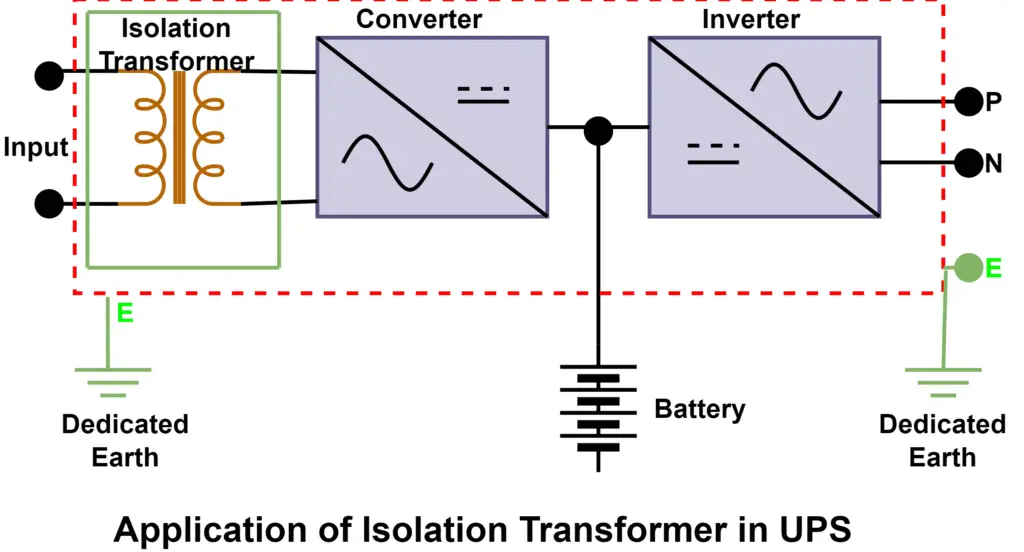
Summary
- An isolation transformer provides galvanic isolation to suppress electric noise to delicate electrical suppression.
- An isolation transformer Improves signal strength in wireless and radio communication.
- It decreases the electromagnetic and electrical interferences from other power devices.
- Isolation transformer decreases the possibility of current leakage and thus rising the standard of power transfer to load.
- Electrical isolation transformer blocks interference caused by the ground loops.
- An isolation transformer does not pass the DC components if any are present in the utility supply.